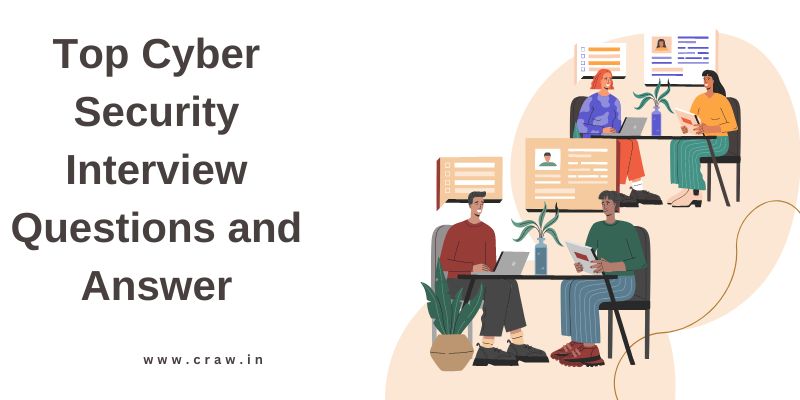Top 100 Cybersecurity Interview Questions and Answers By Craw Security

Top 100 Cybersecurity Interview Questions and Answers By Craw Security
Cybersecurity Interview Questions and Answers
1: What is cybersecurity?
Cybersecurity can be defined as the process of guarding computer systems, networks, devices, and data from theft, illegal access, harm, and other cyber threats. This includes a variety of controls and innovations intended to protect data and guarantee the privacy, reliability, and accessibility of digital resources.
2: What are the main goals of cybersecurity?
The main goals of cybersecurity are as follows:
- Confidentiality,
- Integrity,
- Availability,
- Authentication,
- Authorization,
- Accountability,
- Resilience,
- Awareness and Training, etc.
3: What is the CIA triad in cybersecurity?
The CIA triad is a fundamental concept in cybersecurity that stands for Confidentiality, Integrity, and Availability. It stands for the three primary goals that must be safeguarded and upheld in any security system or setting. In order to guarantee the general security and efficiency of systems, the CIA triad aids in directing the use of security measures and the evaluation of threats.
4: What is the difference between symmetric and asymmetric encryption?
Two distinct cryptographic methods are employed to safeguard data and communication: symmetric encryption and asymmetric encryption. Their primary distinction is in how keys for decryption and encryption are utilized and distributed.
- Symmetric Encryption:
The same key is utilized in symmetric encryption for both encryption and decryption. The person who sends the message and the recipient beforehand communicate through a secure channel to exchange the key. The key is kept private and shouldn’t be available to uninvited guests. Symmetric encryption is useful for encrypting huge volumes of data since the encryption and decryption processes are quick and effective.
- Asymmetric Encryption:
A public key and a private key are used in asymmetric encryption, commonly referred to as public-key encryption. Whereas the private key is kept private and only accessible to the key owner, the public key is extensively used and can be freely circulated. Without a common secret key, asymmetric encryption offers a safe means to transmit encrypted messages.
5: What is a firewall and how does it work?
An internal network, like a corporate network, and an external network, like the Internet, are separated by a firewall, a network security device, or a piece of software. It is intended to watch over and manage incoming and outgoing network traffic in accordance with predefined security policies.
In addition to this, the firewall operates in the following manner:
- Packet Filtering,
- Access Control,
- Stateful Inspection,
- Network Address Translation (NAT),
- Logging and Auditing, etc.
6: Explain the concept of “defense in depth.”
A security tactic known as “defense in depth” is putting in place numerous levels of defense controls and precautions to safeguard computer systems, networks, and data. The idea acknowledges that relying solely on one security solution will not be sufficient to offer complete defense against complex and constantly changing cyber threats. Instead, it promotes the use of layered defenses, each of which adds a layer of protection for a stronger, more durable overall defense.
7: What is a vulnerability assessment?
Vulnerabilities or flaws in computer systems, networks, apps, or other IT infrastructure are identified and evaluated systematically through a vulnerability assessment. It seeks to proactively find security holes that a cyber intruder could use to undermine the system’s privacy, reliability, or accessibility.
8: What is the difference between a vulnerability and an exploit?
In the context of cybersecurity, a vulnerability, and an exploit are related but distinct concepts:
- Vulnerability:
Any weakness or flaw that might be used by a cyber intruder to obtain illicit access, interrupt activities, or jeopardize the reliability, privacy, or accessibility of information is referred to as a vulnerability. Architectural faults, coding mistakes, incorrect setups, or out-of-date software versions can all lead to vulnerabilities. They offer potential avenues of entry that attackers could use to breach a system’s security.
- Exploit:
A particular approach or piece of code known as an exploit, on the contrary, uses a vulnerability to launch an attack or obtain illegal entry into a system or network. Attackers create or find exploits, which may be employed to take advantage of a vulnerability for nefarious objectives.
Exploits are frequently made to target certain shortcomings, utilizing the flaws in a system or program to get around security measures, issue illegal commands, or acquire privileged access. Malware, code scripts, and other harmful payloads are all examples of exploits.
9: What is a security policy?
An organization’s management and protection of its information assets, systems, networks, and resources are outlined in its security policy, which is a defined set of rules, standards, and procedures. It acts as a foundational document that outlines the organization’s security goals, requirements, accountability, and permissible conduct with regard to data security.
10: What is a DDoS attack and how does it work?
A malevolent effort to stop a network, service, or website from being available and functional by flooding it with unauthorized traffic is known as a Distributed Denial of Service (DDoS) attack. In a DDoS assault, a number of hacked computers or devices — known as botnets — work together to send a tremendous amount of traffic to the target, overwhelming it and making it unable to respond to genuine user requests.
Moreover, a typical DDoS attack operates as follows:
- Botnet Creation,
- Command and Control (C&C),
- Attack Initiation,
- Traffic Overload,
- Attack Duration, etc.
11: Explain the concept of least privilege.
According to the principle of least privilege (PoLP), commonly referred to as the concept of least privilege, users and systems should only be given the minimal amount of access required to carry out their approved activities. This adheres to the principle of avoiding unneeded access to vital assets or capabilities while limiting rights and permissions to the absolute minimum necessary to perform particular duties or responsibilities.
The idea behind the least privilege concept is that giving users or systems too many powers raises the possibility of an attack, as well as the danger of illicit entry, abuse, or inadvertent damage. Businesses can lessen the effects of security breaches and reduce the likelihood of hostile activity by following the principle.
12: What is social engineering and what are some common types?
In order to trick individuals or groups into disclosing confidential data, carrying out certain tasks, or allowing unlawful access, social engineering uses psychological and manipulative tactics. It preys on human psychology and uses manipulation to persuade victims into doing things that are advantageous to the attacker by taking advantage of confidence, power, curiosity, or other psychological attributes.
Social engineering attacks come in many different shapes, but some typical ones are Phishing, Pretexting, Baiting, Quid pro quo, Tailgating, Impersonation, Reverse Social Engineering, etc.
13: What is the difference between authentication and authorization?
Authentication and authorization are two distinct but interconnected concepts in the field of information security:
- Authentication:
Checking a user, system, or entity’s identification in order to be confident they are who they say they are is called authentication. It includes verifying the validity of the user or entity’s credentials and figuring out if they are authorized to utilize a given resource or carry out a specific task. Establishing confidence and trust in the identification of the party requesting access is the aim of authentication.
- Authorization:
Getting a person or entity’s permission to utilize or gain access to certain resources, actions, or services is the process of authorization. In this regard, it involves developing and executing access control rules based on the identity, function, or other characteristics of the user. A system’s authorization process makes sure users have the right rights and privileges to carry out particular actions or access particular resources.
14: What is the OWASP Top 10 and why is it important?
The Open Web Application Security Project (OWASP) has compiled an inventory of the 10 most important web application security threats, which are revised frequently. Developers, security experts, and businesses can use it as a reference to comprehend and rank common vulnerabilities that could jeopardize the security of web applications. For example, Injection, Broken Authentication, Sensitive Data Exposure, XML External Entities (XXE), etc.
The OWASP Top 10 is a useful tool to encourage secure online application development best practices and increase public knowledge of common security concerns. This enables enterprises to concentrate their efforts on fixing the most critical vulnerabilities that attackers frequently take advantage of.
15: What is a zero-day vulnerability?
A cyber security flaw or bug in hardware, software, or a system revealed only to the vendor, or researchers is referred to as a zero-day vulnerability. As a result of the developers’ or suppliers’ limited time to fix the flaw before it can be leveraged by attackers, it is known as a “zero-day” vulnerability. In essence, it indicates that attackers are actively exploiting the vulnerability while the manufacturer or developers are uninformed of it.
16: What is a botnet?
A distributed system of hacked computers or other devices that is managed by a hostile actor or “botmaster” is known as a botnet. These hijacked computers, often known as “bots” or “zombies,” frequently get infected with malware that enables the botmaster to manage them without the owner’s authorization or knowledge remotely.
By infiltrating a great number of computers or devices using a variety of techniques, such as abusing security flaws, disseminating email attachments that are malicious, or luring people to click on harmful links, botnets can be built. When compromised devices are infected, they join the botnet and can be utilized for a variety of harmful purposes.
17: How does public key infrastructure (PKI) work?
Public Key Infrastructure (PKI) is a framework that enables secure communication and authentication in a networked environment. In a networked environment, secure communication and authentication are made possible via the Public Key Infrastructure (PKI) framework. To manage digital certificates, public and private key pairs, and the related cryptographic procedures, it offers a collection of policies, methods, and technologies. The basis of PKI is the implementation of asymmetric encryption techniques, which combine a public key and a private key that are mathematically related.
Moreover, below-mentioned is a simplified overview of how PKI works:
- Key Pair Generation,
- Certificate Authority (CA),
- Certificate Enrollment,
- Certificate Issuance,
- Certificate Distribution,
- Certificate Validation,
- Secure Communication,
- Certificate Revocation, etc.
18: What is the role of a security incident response team?
Identification, response, and management of security-related incidents inside a business are the responsibilities of a Security Incident Response Team (SIRT), often referred to as an Incident Response Team (IRT). In the case of an attack on security, SIRTs are essential for reducing the effects of security breaches, reducing risks, and returning things to normal. Their chief duties are as follows:
- Incident Detection and Monitoring,
- Incident Response Planning,
- Incident Triage and Investigation,
- Containment and Eradication,
- Forensics and Evidence Preservation,
- Communication and Reporting,
- Lessons Learned and Continuous Improvement, etc.
19: Explain the concept of encryption.
By applying algorithms for encryption and keys, plaintext (data that can be read and understood) is transformed into ciphertext (data that has been encoded and is not understandable). It is a basic method for preserving the reliability and privacy of data while it is being sent or stored. Encryption makes sure that even if unapproved individuals access the encrypted material, they will be unable to decrypt it and read its contents.
20: What is the difference between a vulnerability scan and a penetration test?
In a nutshell, penetration testing simulates actual attacks to find vulnerabilities and evaluate a company’s safety defenses; vulnerability scanning is a methodical technique for identifying known weaknesses. Both methods are useful for different things and work best when combined to give a complete picture of a company’s security posture. Although penetration testing assists in evaluating the efficiency of security controls and identifying potential holes that may not be obvious through automated scanning alone, vulnerability scanning is an anticipatory strategy for finding and fixing vulnerabilities.
21: What is a hash function, and what is it used for in cybersecurity?
Defined as the “hash value” or “digest,” a hash function is a mathematical operation that accepts as input a fixed-length string of letters referred to as the “message” or “data,” and outputs the result as the “hash value” or “digest.” The hash value, which is the output, is specific to the input data. Therefore, even a minor alteration will result in a drastically distinct hash value. Hash functions are made to handle information quickly, even for massive inputs, because of their speed and efficiency.
In cybersecurity, hash functions are widely used for various purposes:
- Data Integrity Verification,
- Password Storage,
- Digital Signatures,
- Data Deduplication,
- Forensics and File Identification, etc.

22: How does SSL/TLS work?
Safe connections over a network, which is usually the internet, are established using the cryptographic protocols SSL (Secure Sockets Layer) and its successor TLS (Transport Layer Security). The SSL/TLS standards protect the privacy, reliability, and integrity of data transferred between a client (like a web browser) and a server (like a web server).
In addition, the following is a brief description of how SSL/TLS functions:
- Handshake Protocol
- Client Hello
- Server Hello
- Certificate Exchange
- Key Exchange
- Session Key Generation
- Cipher Suite Confirmation
- Secure Data Transfer
- Data Encryption
- Data Integrity
- Data Decryption and Verification
- Session Closure
- Closure Alert
- Closure Handshake
23: What is a VPN and how does it enhance security?
Through the use of a virtual private network, or VPN, a safe and encrypted connection can be established across a public network like the Internet. Even if clients are linked to a public network, they are able to access and transfer data secretly and safely as if they were directly associated with a private network.
24: Explain the concept of multi-factor authentication.
Multi-factor authentication (MFA), often referred to as two-factor authentication (2FA) or layered authentication, is an authentication method that necessitates that users present two or more distinct forms of proof of their identity before being granted access to a system, application, or service. In addition to the conventional username and password authentication, it offers another level of protection. The tenet of “something you know, something you have, and something you are” serves as the foundation for MFA.
25: What is a honeypot, and how is it used in cybersecurity?
A honeypot is a fake system or network that is used in cybersecurity to lure in and trick prospective adversaries. It is a deliberately exposed, segregated ecosystem that seems to hold significant info or resources, but its main objective is to learn more about attackers, their methods, and their motivations. Honeypots are a useful tool for researching and comprehending cyber dangers as well as a proactive security strategy.
26: What is the role of encryption in securing data at rest and in transit?
In order to protect data while it is in transit as well as at rest, encryption is essential. It is a fundamental approach used to safeguard the privacy and security of the data and prevent unwanted utilization of private information. Here is a clarification of how encryption is used to protect data both in transit and at rest:
- Data at Rest:
Data that is stored or persistent on tangible or digitally stored gadgets, including hard drives, databases, or cloud storage, is referred to as data at rest. Regardless of whether the data is inactive or kept for a long time, encryption is employed to prevent illegal access. Encrypting data at rest is primarily done to stop unauthorized parties from obtaining or viewing the data, even if they are able to acquire direct or logical entry to the storage media.
- Data in Transit:
Data that is being sent via a network or communication route, like the internet or internal networks, is referred to as data that is in transit. In order to avoid illegal interception, eavesdropping, or tampering during transmission, encryption is employed to safeguard the privacy and security of data while it is in motion.
27: What is the difference between a virus, worm, and Trojan horse?
Malicious software (malware) includes Trojan horses, worms, and viruses; nevertheless, they differ from one another in terms of how they behave and spread. The distinctions between viruses, worms, and Trojan horses are described as follows:
- Virus: A computer virus is harmful software that contaminates a host program or hooks itself to executable files, moves from one computer to another, and propagates through user interaction or the running of an infected file. Viruses frequently have a specified payload, like corrupting data, destroying files, or impairing system performance. They can spread via downloaded files from the internet, portable storage devices, or malicious email attachments. In addition, the majority of the time, human actions — like clicking a virus-ridden email attachment or launching an infected program — are what allow viruses to spread.
- Worm: Computer worms are standalone programs that replicate themselves and propagate throughout computer networks without the involvement of the user or the requirement to affix themselves to host files. Worms use network protocol flaws or security holes to replicate and obtain illicit entry to systems. They have a quick rate of spread and can quickly infect various systems. Worms are frequently capable of scanning network connections, taking advantage of weaknesses, and self-propagating by transmitting replicas of themselves to other machines. In contrast to viruses, worms can spread independently of current applications or data.
- Trojan Horse: A Trojan horse, or a merely Trojan, is a form of malware that impersonates trustworthy or practical software and tempts users into running or installing it. Trojans do not multiply or propagate automatically as viruses and worms do. As an alternative, they use social engineering strategies to trick consumers into setting them up. Trojans can be made to carry out a variety of nefarious tasks, including gaining illegal access to a system, capturing confidential data, or opening backdoors for external attackers. They may be disseminated via rogue websites, email attachments, or software bundles that appear to be legitimate.
In general terms, the main differences between viruses, worms, and Trojan horses are:
- Propagation Method
- Attachment to Host Files
- Means of Spread
28: Explain the concept of network segmentation.
The act of segmenting a computer network into smaller subnetworks also referred to as segments or subnets, is known as network segmentation. As a result of the isolation between segments, the network is divided into several zones or borders. Network segmentation increases security, boosts network efficiency, and manages traffic.
29: What is the principle of least privilege (PoLP)?
Giving people or systems only the minimal degree of permissions or privileges necessary for them to carry out their specified jobs or responsibilities is recommended by the principle of least privilege (PoLP), a cybersecurity concept and best practice. The guiding principle is founded on the notion that restricting access rights lowers the possibility of accidental or deliberate misuse, unlawful entry, and the possible consequences of a security breach.
30: What is a digital certificate and how does it work?
A digital certificate, sometimes referred to as a public key certificate or an SSL/TLS certificate, is a document that can be used to confirm the accuracy and reliability of data in the digital realm. It serves to set up safe communications, verify the identification of individuals or organizations, and enable encryption. It is issued by a dependable third party known as a certificate authority (CA).
31: What is a man-in-the-middle attack, and how can it be prevented?
A hacking attempt known as a “man-in-the-middle” (MITM) occurs when an intruder intercepts and modifies messages between the two sides without either party’s knowledge or consent. The assailant places oneself in the path of communication, giving them the opportunity to eavesdrop, alter, or introduce harmful material. Gaining unlawful possession of sensitive data, including login credentials, financial information, or personal information, is the aim of an MITM attack.
32: Explain the concept of risk assessment in cybersecurity.
Identification, evaluation, and prioritization of possible dangers and weaknesses to the information systems of a company, assets, and data are all part of the crucial cybersecurity process known as risk assessment. It generally assists companies in comprehending their present security posture, evaluating the impact that hazards and weaknesses may have, and selecting effective risk mitigation measures.
33: What is a password hash, and why is it used?
An encrypted version of a password generated by a hash function is called a password hash. The method, which is one-way, uses a password as an input and outputs a fixed-length character string referred to as the hash value or password hash. Password hashes are primarily used to increase security by safeguarding user passwords.
Moreover, we have jotted down the mainstream reason for which the password hashes are thoroughly used:
- Password Storage Security,
- Protection against Password Guessing and Cracking,
- Individual Password Verification,
- Salted Hashes for Increased Security,
- Compatibility with Authentication Protocols, etc.
34: What is the difference between symmetric and asymmetric encryption algorithms?
Two major categories of algorithms for encryption employed in cybersecurity are symmetric and asymmetric algorithms. In addition, the two are different in the following ways:
- Symmetric Encryption:
The same key is used for both encryption and decryption in symmetric encryption, sometimes referred to as secret-key or shared-key encryption. The secret key is kept private and must initially be disclosed to all persons involved in the communication. The data is converted from plaintext to ciphertext using the key and vice versa.
- Asymmetric Encryption:
A set of mathematically associated keys — a public key and a private key — are used in asymmetric encryption, commonly referred to as public-key encryption. Although the private key remains a secret, the public key is shared without restriction. Only the associated private key can be used to decrypt data encrypted with the public key, and vice versa.
35: What is a web application firewall (WAF), and why is it important?
A security tool called a web application firewall (WAF) is made to shield web-based applications against different online dangers and assaults. It is positioned somewhere between the web app and the client (such as a web browser) and examines HTTP/HTTPS traffic to find and stop unwanted activity and potential security flaws.
In addition, below are some reasons a web application firewall is crucial:
- Protection against Web Application Attacks,
- Vulnerability Mitigation,
- Bot and Malicious Bot Detection,
- DDoS Protection,
- Logging and Monitoring,
- Compliance Requirements,
- Layered Defense, etc.
36: Explain the concept of data loss prevention (DLP).
Data Loss Prevention (DLP) is a group of safety standards and tools intended to guard against the theft or illicit sharing of confidential information within a company. In this regard, DLP’s main objective is to prevent sensitive and secret data from being stolen, leaked, compromised, or disclosed to unapproved people or organizations.
37: What is a security audit, and what is its purpose?
A business’s safety mechanisms, rules, processes, and technical facilities are systematically evaluated and assessed as part of a security audit to ascertain the efficacy of its safety precautions. Finding vulnerabilities, flaws, and non-compliance with safety norms or regulations are the main goals of a security audit. It assists businesses in better understanding their security posture, making wise decisions, and taking the necessary steps to increase their overall security.
38: What is the role of antivirus software in cybersecurity?
By defending computer systems and networks from different kinds of harmful software, often referred to as malware, antivirus software, typically known as anti-malware software, plays a crucial role in cybersecurity. Additionally, the function of antiviral software is described as follows:
- Malware Detection and Prevention,
- Real-Time Protection,
- Behavioral Analysis,
- Regular Updates,
- Scanning and Removal Tools,
- Web Protection,
- Additional Security Features, etc.
39: What is a virtual machine (VM), and how is it used in cybersecurity?
Multiple operating systems can run concurrently on just one machine due to a software tool known as a virtual machine (VM). Every virtual machine functions as a separate, autonomous ecosystem with its own operating system, programs, and virtual hardware.
Moreover, a virtual machine is widely used in cybersecurity for diverse purposes, such as the following:
- Definition and Function,
- Sandboxing and Isolation,
- Malware Analysis and Research,
- Penetration Testing and Vulnerability Assessment,
- Training and Education,
- Rapid Deployment and Scalability,
- Snapshot and Recovery, etc.
40: Explain the concept of secure coding practices.
Secure coding practices are a set of rules, ideas, and methods that programmers use to reduce flaws and improve the safety of their code throughout the software development lifecycle. Establishing strong, resilient programs that can fend off harmful attempts and safeguard confidential information requires secure coding.
41: What is a buffer overflow, and how does it work?
A software program bug known as a buffer overflow happens when an application or procedure tries to write data outside of a buffer, overwriting nearby memory locations. This may result in a number of security problems, such as crashes, application errors, and potential hacker exploitation.
In addition, you can refer to the below-mentioned points to know the working mechanism of buffer overflow:
- Buffer and Memory Allocation,
- Insufficient Bounds Checking,
- Writing Beyond the Buffer,
- Overwriting Control Data,
- Code Execution and Exploitation,
- Denial of Service (DoS),
- Mitigation and Prevention, etc.
42: What is a SQL injection attack and how can it be prevented?
When an intruder inserts inappropriate malicious SQL code into a web app’s dataset query, it is referred to as a SQL injection attack. This gives an intruder the ability to alter data, manipulate the app’s confidential data, retrieve private info from the application’s database, or even run arbitrary commands. One of the most prevalent and dangerous online application security vulnerabilities is SQL injection attacks.
Preventing SQL Injection Attacks can be done with the following methodologies:
- Input Validation and Sanitization,
- Parameterized Queries/Prepared Statements,
- Escaping Special Characters,
- Least Privilege Principle,
- Secure Coding Practices,
- Web Application Firewall (WAF),
- Regular Patching and Updates,
- Security Testing and Code Review, etc.
43: What is the role of biometrics in authentication?
The evaluation and study of a person’s distinctive physical or behavioral traits, such as their fingerprints, iris patterns, facial features, voice, or writing sequences, is known as biometrics. These distinguishing characteristics are used in biometric authentication for verifying and authenticating people’s identities. In contrast to conventional authentication techniques like passwords or PINs, biometrics plays the role of providing a more secure and trustworthy way of confirming a person’s identification.
44: Explain the concept of secure socket layer (SSL) and transport layer security (TLS).
Secure communication over the internet is made possible by the cryptographic technologies Secure Socket Layer (SSL) and Transport Layer Security (TLS). They create an encrypted link between a client (like a web browser) and a server (like a website) to make certain that any data sent between them is secure and can’t be seen by anyone else.
45: What is a rainbow table, and how is it used in password cracking?
A pre-computed table known as a rainbow table comprises an extensive amount of potential plaintext passwords along with the accompanying hash values. It is a time-saving method for swiftly reverse-engineering hashed passwords that are employed in password breaking.
Moreover, it can genuinely be used in cracking varied passwords with the following techniques:
- Password Hashing,
- Hash Lookup,
- Rainbow Table Approach,
- Hash Lookup Optimization,
- Reduction Chains,
- Limitations and Countermeasures,
46: What is a network protocol analyzer (packet sniffer), and how is it used?
A network protocol analyzer, also called a packet sniffer, is a tool that is utilized to record, examine, and decipher network traffic either in real-time or from capture files that have been saved. It enables developers, security experts, and network administrators to inspect the data packets moving via a network.
In addition, the main working procedure of a network protocol analyzer is mentioned below:
- Capturing Packets,
- Analyzing Packet Contents,
- Identifying Network Issues,
- Monitoring Network Security,
- Troubleshooting Applications,
- Protocol Development and Testing,
- Security and Privacy Considerations, etc.
47: What is the principle of defense in depth and how does it apply to cybersecurity?
Defense in depth is genuinely a cybersecurity tactic that entails putting in place numerous layers of safety controls and precautions to safeguard a company’s information and systems. It acknowledges that using just one security technique to protect against more complicated is insufficient. Instead, a multi-layered strategy is used to offer security methods that overlap and work in conjunction. In addition, with the following methodologies, the defense in depth applies to cybersecurity:
- Layered Security Controls,
- Diverse Security Technologies,
- Redundancy and Resilience,
- Defense at Different Attack Stages,
- Security Awareness and Training,
- Regular Monitoring and Updating, etc.
48: Explain the concept of access control in cybersecurity.
The technique of regulating and overseeing the utilization of computer systems, networks, data, and other assets is known as access control in the field of cybersecurity. It includes setting in place procedures and guidelines that specify who has access to what data and resources and under what restrictions. Protecting sensitive information, preserving the confidentiality, integrity, and accessibility of resources, as well as preventing unwanted access and misuse are the key objectives of access control.
49: What is a security information and event management (SIEM) system?
Software that integrates the features of security event management (SEM) with security information management (SIM) is known as a security information and event management (SIEM) system. It offers businesses a single platform for gathering, examining, and comparing security event data from diverse sources inside their IT infrastructure. A SIEM system’s main goal is to assist enterprises in both detecting and responding to security issues and in meeting regulatory requirements.
50: What is the difference between black hat, white hat, and gray hat hackers?
The primary difference between black hat, white hat, and gray hat hackers is mentioned below:
- Black Hat Hackers: Black hat hackers, often known as “malicious hackers,” take part in illegal actions with the aim of exploiting weaknesses, stealing data, causing harm, or carrying out other illegal activities. The majority of the time, they act illegally and with bad intentions. Black hat hackers can target people, businesses, or even government networks for monetary gain, disruption, or personal advantage.
- White Hat Hackers: The talents of white hat hackers, commonly referred to as “ethical hackers” or “security researchers,” are used to find and remedy security flaws. They perform penetration testing, vulnerability analyses, and security audits legally and with the owners’ consent. White hat hackers assist enterprises in strengthening their security by identifying gaps before malevolent intruders can take advantage of them. When doing their things, they comply with ethical standards and the law.
- Grey Hat Hackers: Between black hat and white hat hackers is the gray hat group. They don’t explicitly intend to cause harm, unlike black hat hackers, but they might take unapproved actions to find weaknesses if no one else is looking. Even though they have good intentions, since they operate without official permission, their actions are nonetheless illegal. Gray hat hackers may reveal vulnerabilities they find, but they don’t ask for permission first, and they don’t adhere to established responsible disclosure standards.
51: What is a virtual private network (VPN), and how does it provide secure communication?
Using a virtual private network (VPN), you can establish safe and secure access over a public network like the Internet. This offers a safe route for data transfer between your gadget and the network or service you are using.
All of your information is encrypted and transferred over a tunnel built by the VPN service when you use it to access the internet. Your online actions, including your browsing history, emails, messages, and file transfers, are safeguarded by this encryption against being intercepted or tracked by unauthorized parties.
52: Explain the concept of secure coding practices.
Secure coding practices constitute a collection of methods and recommendations that programmers use to create a program that is resistant to security flaws and exploits. These procedures try to lessen the chance that a computer’s safety, reliability, or accessibility will be compromised by security problems, like software flaws and shortcomings.
53: What is a distributed denial-of-service (DDoS) attack and how can it be mitigated?
A distributed denial-of-service, or DDoS, attack is a deliberate attempt to stop a system, network, or website from operating normally by flooding it with requests for resources or incoming traffic. A botnet of hacked machines or other devices, such as computers, is used in a DDoS assault to organize the synchronized sending of an enormous amount of traffic to the intended system, rendering it hard for authorized users to make use of the service.
54: What is the difference between symmetric and asymmetric encryption algorithms?
The main differences between symmetric and asymmetric encryption algorithms are mentioned below:
| Symmetric Encryption | Asymmetric Encryption |
| Symmetric encryption, also known as secret key encryption or conventional encryption, uses the same key for both encryption and decryption processes. | Asymmetric encryption, also called public key encryption, uses a pair of mathematically related keys: a public key and a private key. |
| The key used to encrypt the data is also used to decrypt it. This means that the sender and the recipient must share the same secret key in advance. | The public key is freely distributed and used for encryption, while the private key is kept secret and used for decryption. |
| Symmetric encryption algorithms are generally faster and more efficient for large volumes of data. | ● When a sender wants to send an encrypted message to a recipient, they use the recipient’s public key to encrypt the data. The recipient, in turn, uses their private key to decrypt the message.
● Asymmetric encryption provides a solution for secure communication without the need for prior key exchange. ● Asymmetric encryption algorithms are computationally more intensive and slower compared to symmetric algorithms. |
| Examples of symmetric encryption algorithms include Advanced Encryption Standard (AES), Data Encryption Standard (DES), and Triple Data Encryption Standard (3DES). | Examples of asymmetric encryption algorithms include RSA (Rivest-Shamir-Adleman), Diffie-Hellman, and Elliptic Curve Cryptography (ECC). |
55: What is a web application firewall (WAF), and why is it important?
A security tool called a web application firewall (WAF) is made to shield web applications from various threats and weaknesses. The program stands between the client and the online application and examines incoming and outgoing web traffic to spot and neutralize potential risks.
In addition, the web application firewall (WAF) is important in so many ways, such as the following:
- Protection against Common Web Application Attacks,
- Vulnerability Patching and Virtual Patching,
- Protection for Zero-Day Attacks,
- Web Traffic Monitoring and Logging,
- Granular Access Control,
- Protection from Botnets and Scrapers,
- Compliance and Regulatory Requirements,
- Continuous Security Monitoring and Adaptation, etc.
56: Explain the concept of data loss prevention (DLP).
Data loss prevention (DLP) is a collection of security procedures, guidelines, and tools designed to guard against the loss, leak, or illicit acquisition of sensitive or vital data. During its existence, whether at rest or in transit, sensitive data must be identified, categorized, monitored, and protected.
57: What is a security audit, and what is its purpose?
A company’s information systems, facilities, operations, and regulations are systematically evaluated as part of a security audit to determine whether they adhere to security norms and best practices. An organization’s security posture is audited for vulnerabilities, risks, and weaknesses with the goal of making recommendations on how to strengthen security and reduce potential threats.
However, the main purposes of a security audit are as follows:
- Assessing Security Controls,
- Evaluating Compliance,
- Identifying Vulnerabilities and Risks,
- Testing Incident Response Preparedness,
- Reviewing Physical Security Controls,
- Providing Recommendations, etc.
58: What is the role of antivirus software in cybersecurity?
By offering defense against numerous forms of malware and dangerous threats, antivirus software plays a crucial part in cybersecurity. Malicious software detection, prevention, and removal from machines and networks are its main goals.
Moreover, the primary aspects of antivirus software in cybersecurity are as follows:
- Malware Detection,
- Real-time Threat Prevention,
- Regular System Scanning,
- Removal of Infected Files,
- Protection Against Exploits and Vulnerabilities,
- Updates and Signature Database,
- Email and Web Protection,
- Security Awareness, etc.
59: What is a virtual machine (VM) and how is it used in cybersecurity?
Multiple operating systems (OS) can operate concurrently on one physical machine because of the use of virtual machines (VMs), which are software emulations of real computer systems. The CPU, storage space, memory, and network connections are just a few of the virtual hardware resources that each virtual machine has access to and uses independently.
In the field of cybersecurity, virtual machines are widely used for various purposes:
- Sandboxing and Malware Analysis,
- Penetration Testing and Ethical Hacking,
- Training and Education,
- System Hardening and Configuration Testing,
- Network Segmentation and Isolation,
- Incident Response and Forensic Analysis, etc.
60: Explain the concept of secure coding practices.
In order to build software that is immune to vulnerabilities and lowers the risk of security defects and exploits, software developers use a set of rules, concepts, and methods known as safe coding procedures. Producing software that is strong, dependable, and resistant to harmful attacks is the aim of safe coding. For example, Input Validation, Output Encoding, Authentication and Authorization, Secure Error Handling, Secure Session Management, Secure Communication, Secure File Handling, Secure Configuration, Secure Third-Party Libraries, Secure Coding Training and Review, etc.
61: What is a buffer overflow, and how does it work?
A software flaw known as a buffer overflow happens when an application tries to maintain more information in a buffer than the buffer can handle. A buffer is a short-term storage region in computer memory. The additional data overflows into nearby memory locations, possibly overwriting crucial information or running dangerous code. System breakdowns, security lapses, or even remote code execution can result from buffer overflows.
62: What is a SQL injection attack, and how can it be prevented?
An attacker can change or insert malicious SQL statements into a database query made by an application, circumventing security protections and obtaining access to the database or changing its contents. This is known as a SQL injection attack. When user input is used in a SQL query without being properly verified or sanitized, it happens.
Further, below mentioned are some primary techniques by which an SQL Injection can be prevented:
- Input Validation and Parameterized Queries,
- Least Privilege Principle,
- Whitelisting Input,
- Sanitization and Escaping,
- Database Firewall,
- Regular Security Patching,
- Security Testing and Code Review, etc.
63: What is cyber security course?
A package of fundamentals of cyber security in a compiled way to let a learner understand all the things so precisely is known as a cyber security course. In this context, a learner can grab all the necessary skills and abilities need to secure one’s place as a proven cybersecurity analyst with the best cybersecurity practices. In case you are planning to go through a global-standard 1 Year Diploma in Cyber Security Course, you may inquire about Craw Security which will provide you with all the required knowledge and cybersecurity solutions.
64: Which course is best for cyber security?
Those who want to work in cybersecurity can choose from a wide variety of courses. The optimal course for you will depend on your existing skill level, particular cybersecurity interests, and professional objectives. In this regard, you can choose the 1 Year Diploma in Cyber Security Course by Craw Security, the Best Cybersecurity Training Institute in India with top-notch training instructors having many years of crucial work experience and skills that cannot be beaten by anyone else in the market.
65: Is there cyber security in DU?
Yes, there is specialized training related to cyber security at Delhi University. In this regard, there is a Certificate Course in Ethical Hacking & Cyber Security offered by the University of Delhi in association with the RK College of Systems and Management (RKCSM).
66: What is the qualification in cyber security?
Different institutions have their own eligibility criteria for their cybersecurity courses. Some offer this course with a bachelor’s degree with some necessary aggregated marks in some disciplines, while some offer in mere showcasing a 12th passed certificate from a recognized board from anywhere in the world.
67: Is cybersecurity a good career?
Yes, it is often believed that a career in cybersecurity is both satisfying and promising in this modern world. Moreover, there are several reasons why cybersecurity can be seen as a good career choice in today’s scenario:
- High Demand for Professionals,
- Career Growth and Advancement,
- Diverse Job Opportunities,
- Competitive Salaries,
- Constant Learning and Skill Development,
- Global Opportunities,
- Impact and Importance, etc.
68: Is cyber security easy?
Although it is not always simple, cybersecurity is a subject that can be acquired and mastered with the correct attitude, commitment, and ongoing learning. Below are some of the concerning points to be understood for cyber security:
- The Complexity of Cyber Threats,
- Technical Knowledge and Skills,
- Continuous Learning and Adaptation, and
- Real-World Complexity.
69: What are the 5 types of cyber security?
The main 5 types of cyber security are as follows:
- Network Security,
- Application Security,
- Information Security,
- Endpoint Security,
- Cloud Security, etc.
70: What is the monthly income of cyber security?
The amount you make each month in the cybersecurity field might vary widely depending on your job title, level of expertise, location, industry, and the particular company you work for. Certifications, additional education requirements, and the need for cybersecurity specialists in the labor market can all affect salaries. It’s crucial to remember that the numbers given here are approximations and may differ significantly.
71: Who can join cyber security?
Different institutions have their own eligibility requirements as well as criteria for taking register submissions from distinguished learners. In this regard, Craw Security is asking rate as the eligibility criteria for a cyber security diploma course is the 12th passed certificate from a recognized certificate.
Moreover, students can join this course after having a word with our educational counselors at +91-9513805401 or directly connect with us over WhatsApp.
72: Is cyber security a btech?
Cybersecurity is an area or discipline that can be studied inside a B.Tech degree or via various training pathways, not a Bachelor of Technology (B.Tech) program in and of itself. Moreover, several colleges and universities have started offering cybersecurity in B.Tech. Apart from it, several other cyber security institutions are there that offer world-class Cyber Security Diploma Courses under the guidance of proactive training instructors.
Call now at +91-9513805401 to know more about the upcoming batches and other relevant details.
73: Is cyber security good for freshers?
Yes, cyber security can be understood by freshers. There are plenty of dignified cyber security institutions that propose world-class training and certification in this domain and its subdomains, such as Craw Security, the leading cyber security institute in India with the most satisfied students all over the globe. Moreover, the institute offers many courses supporting full affinity to freshers. I.e., learners can start here from scratch to understand various functionalities of the cyber security fundamentals from the grassroots level.
74: Is cyber security a 9 to 5 job?
The working conditions and scheduling of cybersecurity positions can differ. Many careers in this industry often call for mobility as well as accessibility outside of standard working hours, even though some cybersecurity specialists may hold normal 9 to 5 occupations.
75: Is cyber security coding?
We can state that coding is a crucial talent in practically every area of technology, and cybersecurity is no different. Coding is a crucial component of cybersecurity. However, it is not the only area of interest. Beyond coding, a broad spectrum of knowledge and abilities are required for cybersecurity. Some of the main points to consider include:
- Secure Coding,
- Vulnerability Analysis and Exploitation,
- Scripting and Automation,
- Security Tool Development, etc.
76: Is cybersecurity a stressful job?
Yes, working in cybersecurity can be difficult. Safeguarding computer systems, networks, and data from unwanted access, breaches, and other cyber dangers is the focus of the field of cybersecurity. Cybersecurity experts are in charge of finding weaknesses, putting security measures in place, keeping an eye on systems for potential attacks, and handling events.
77: Is cyber security a government job?
Although it is not only a government position, cybersecurity is widely used in government enterprises. Specialists in cybersecurity are needed by both public and private sector organizations to safeguard their infrastructure, networks, and data.
Due to the sensitivity of the data they handle, a number of government departments and agencies give cybersecurity priority. They involve the defense industry, intelligence services, law enforcement, and other government institutions in charge of vital public services, national security, or crucial infrastructure.
78: Which is the highest-paying IT job?
Some of the highest-paying IT jobs are mentioned below:
- Chief Information Officer (CIO),
- IT Architect,
- Data Scientist,
- DevOps Engineer,
- Security Consultant/Architect, and many more.
79: Which job is the highest salary in India?
The industries with the highest salaries in India are often those related to finance, information technology, management consulting, and the oil and gas sector. Despite the fact that pay may differ based on experience, education, and region, the following professions frequently pay well in India:
- Chief Executive Officer (CEO),
- Information Technology (IT) Professionals,
- Investment Bankers,
- Management Consultants,
- Petroleum Engineers, etc.
80: How do I apply for cyber security?
To apply for a career in cybersecurity, you can follow these general steps:
- Determine your interests and career path,
- Acquire the necessary education and certifications,
- Gain practical experience,
- Build a professional network,
- Prepare your resume and cover letter,
- Apply for cybersecurity positions,
- Prepare for interviews,
- Continuously learn and adapt, etc.
81: How many years is cyber security?
Depending on a person’s educational background, amount of expertise, and job objectives, the length of a cybersecurity career might vary. Here are some typical benchmarks and rough timelines:
- Entry-level Education,
- Certifications,
- Entry-level Positions,
- Mid-level and Senior Positions,
- Specialization and Advanced Education, etc.
82: What is the fee for cyber security?
The cost of cybersecurity education and training can vary greatly based on a number of variables, such as the degree of education, the institution or supplier of the training, the location, the length of the program, and the mode of course delivery (online or in-person).
83: What is the scope of cyber security?
The scope of cybersecurity is enormous and is constantly growing as a result of the development of technology and the sophistication of cyber threats. The most significant areas demonstrate the broad scope of cybersecurity:
- Protecting Networks and Systems,
- Securing Data and Privacy,
- Threat Detection and Incident Response,
- Vulnerability Management,
- Security Governance and Compliance,
- Emerging Technologies and Trends,
- Cybersecurity Consulting and Education, etc.
84: What type of career is cyber security?
Numerous job options in cybersecurity are available, each with a distinct specialty and set of duties. Some of them are as follows:
- Security Analyst,
- Penetration Tester,
- Incident Responder,
- Security Engineer,
- Security Architect,
- Cryptographer,
- Security Consultant,
- Forensic Analyst,
- Security Manager,
- Chief Information Security Officer (CISO),
85: What is the future of cyber security in India?
The future of cybersecurity in India is promising as the country continues to witness rapid digital transformation and an increasing reliance on technology. Apart from it, the mainstream factors that are genuinely responsible for a sound future of cyber security in India are Growing Demand, Government Initiatives, Data Protection and Privacy, Skill Development, Cybersecurity Startups and Innovation, International Collaborations, etc.
86: What is the scope of cyber security in India?
The importance of cybersecurity in India is enormous and is constantly expanding as the nation rapidly digitizes and encounters more sophisticated cyber threats. The following significant factors demonstrate the importance of cybersecurity in India:
- Increasing Cyber Threat Landscape,
- Digital Transformation,
- Government Initiatives,
- Data Protection and Privacy,
- Skill Development and Job Opportunities,
- Startups and Innovation,
- International Collaborations, etc.
87: Is cybersecurity in demand?
Yes, cybersecurity is highly in demand in India and other countries of the world due to the sudden upsurge in the number of cyber attacks on almost every organization, regardless of its size, scope, extent, niche, and other corresponding factors.
88: Who looks after cyber security?
To protect digital systems, networks, and data, multiple organizations work together in an endeavor known as cybersecurity. The following are some significant players involved in cybersecurity:
- Individuals,
- Organizations,
- Cybersecurity Professionals,
- Government Agencies,
- Law Enforcement Agencies,
- Regulatory Bodies,
- Technology Providers,
- International Organizations, etc.
89: What is the salary of cyber security in India per month?
Depending on aspects including experience, education, job function, industry, region, company size, and reputation, cybersecurity specialists’ salaries in India can vary. Additionally, salaries between entry-level jobs and senior-level or specialized professions can differ tremendously. Following are approximate pay ranges for several cybersecurity professions in India, nevertheless, to give you a rough idea:
- Entry-Level Positions:
- Security Analyst: INR 3,00,000 – 6,00,000 per annum (INR 25,000 – 50,000 per month)
- Network Security Engineer: INR 3,00,000 – 6,00,000 per annum (INR 25,000 – 50,000 per month)
- Ethical Hacker: INR 3,00,000 – 6,00,000 per annum (INR 25,000 – 50,000 per month)
- Mid-Level Positions:
- Security Consultant: INR 6,00,000 – 15,00,000 per annum (INR 50,000 – 1,25,000 per month)
- Incident Responder: INR 6,00,000 – 12,00,000 per annum (INR 50,000 – 1,00,000 per month)
- Security Engineer: INR 6,00,000 – 12,00,000 per annum (INR 50,000 – 1,00,000 per month)
- Senior-Level Positions:
- Security Architect: INR 12,00,000 – 30,00,000 per annum (INR 1,00,000 – 2,50,000 per month)
- Chief Information Security Officer (CISO): INR 20,00,000 – 50,00,000 per annum (INR 1,65,000 – 4,15,000 per month)
90: What skills are required for cyber security?
The following skills are sincerely required for the multi-purpose works of cyber security:
- Technical Knowledge,
- Information Security,
- Threat Intelligence,
- Risk Assessment and Management,
- Incident Response,
- Ethical Hacking and Penetration Testing,
- Communication and Collaboration,
- Continuous Learning and Adaptability,
- Analytical and Problem-Solving Abilities,
- Ethical and Legal Understanding, etc.
91: Which is better, cybersecurity or data science?
Depending on your interests, abilities, career ambitions, and the particular prospects in each profession, you may choose to choose between data science and cybersecurity. Both data science and cybersecurity provide exciting career options and special benefits.
If you wish to go into cybersecurity, then you may choose courses inclined toward it; otherwise, you may pursue data science if you are more interested in that domain.
92: Which country has high demand for cyber security?
Businesses and governments around the world are in high demand for cybersecurity due to the growing number of cyber threats. Nevertheless, due to variables like the adoption of cutting-edge technology, robust digital infrastructure, a large number of enterprises, and an elevated level of cyber threats, certain countries have an especially great need for cybersecurity specialists.
93: Is BSc cyber security good?
For those who have an interest in continuing a career in cybersecurity, earning a Bachelor of Science (BSc) in Cybersecurity may be a wise move. Hence, you may join certain colleges or universities that are proposing this B.Sc. in Cybersecurity under the guidance of well-qualified trainers.
Moreover, if you wish to learn more about cybersecurity in a shorter period of time, like one year or less, you may consider joining Craw Security, the Best Cybersecurity Training Institute in India. In addition, Craw offers primetime cybersecurity courses under the premier guidance of highly qualified, skilled, motivated, and experienced trainers.
94: What is the salary of a cyber security analyst in Wipro?
A cybersecurity analyst’s pay at Wipro, or at any other organization for the same reason, can vary depending on things like experience, education, location, and the payment arrangement of the company. It is difficult to obtain an exact amount because salary data is not accessible to the public for particular positions at specific organizations.
However, for entry-level roles, the wage range for a cybersecurity analyst in India might be between INR 25,000 – 50,000 per month (INR 3,00,000 – 6,00,000 per year). Senior-level analysts may earn higher wages based on their expertise and responsibilities, whereas mid-level analysts can anticipate a compensation range of INR 6,00,000 – 10,00,000 per year (INR 50,000 – 85,000 per month).
95: What is the salary of a cyber security analyst in TCS?
As per AmbitionBox, the salary of cybersecurity analysts in Tata Consultancy Services is around ₹ 4.6 Lakhs annually for a person having around 2 to 3 years of experience.
96: What is the lowest salary for cyber security in India?
As per AmbitionBox, the lowest salary of a cyber security analyst in India is something around ₹2.6 LPA, which comes from the pay slab range of ₹2.6 – ₹3.8 LPA, reported from 872 candidates.
97: How can I join cyber security after the 12th?
After completing 10+2 from a recognized board, you may join cybersecurity at Craw Security under the guidance of a proactive training instructor having many years of quality experience.
98: Which country has the weakest cyber security?
According to an independent survey conducted by Comparitech, Tajikistan is the least cyber-secure country in the world, followed by Bangladesh and China.
99: What is the rank of India for cybercrime in the world?
As per the survey by Comparitech, India ranks in the 6th spot on the cybercrime index of the world countries.
100: What is the salary of an ethical hacker in India?
The Salary of the ethical hackers in India is mentioned below:
- Entry-Level Positions:
- Junior Ethical Hacker: INR 3,00,000 – 6,00,000 per annum (INR 25,000 – 50,000 per month)
- Mid-Level Positions:
- Ethical Hacker: INR 6,00,000 – 12,00,000 per annum (INR 50,000 – 1,00,000 per month)
- Senior-Level Positions:
- Senior Ethical Hacker: INR 12,00,000 – 25,00,000 per annum (INR 1,00,000 – 2,00,000 per month)
















